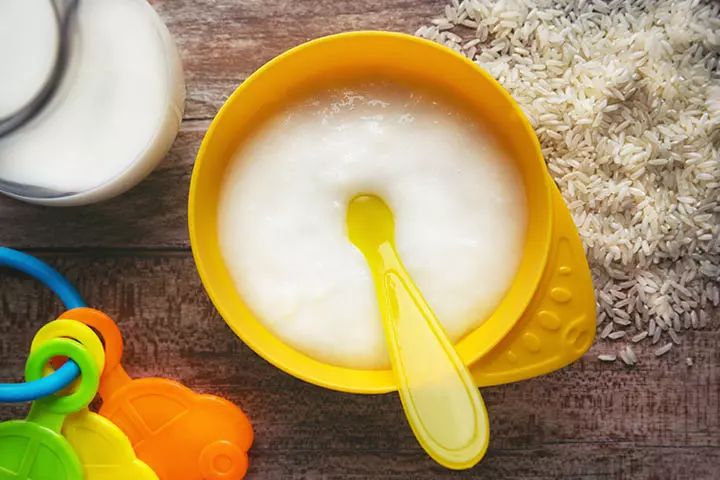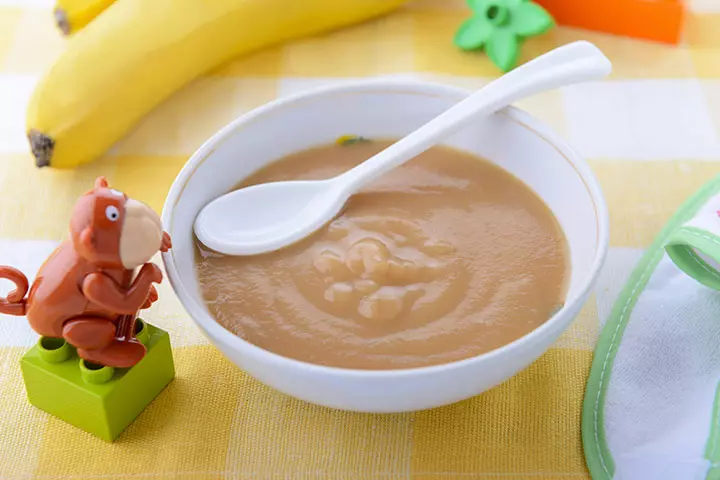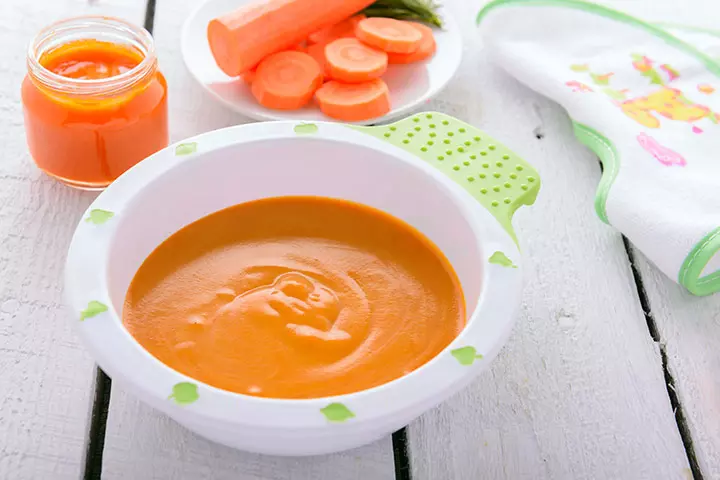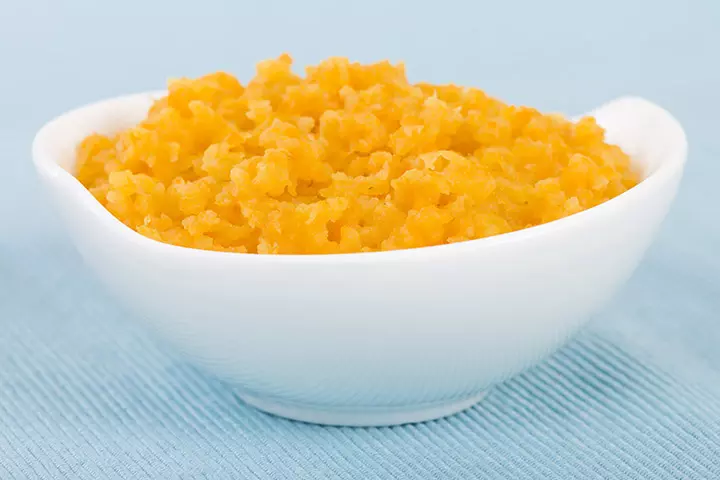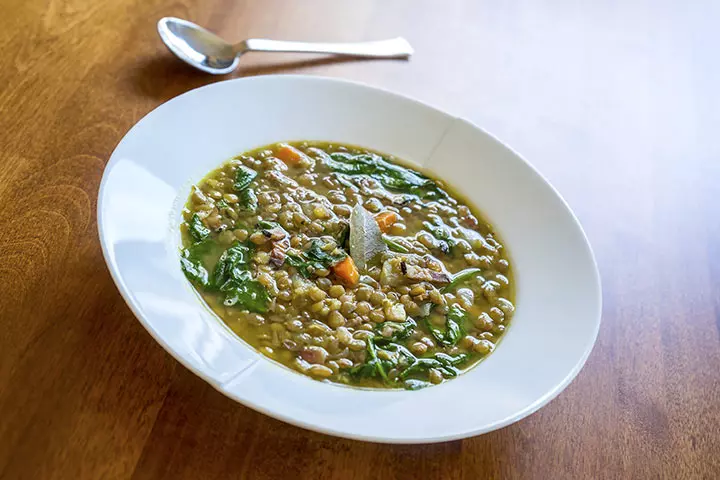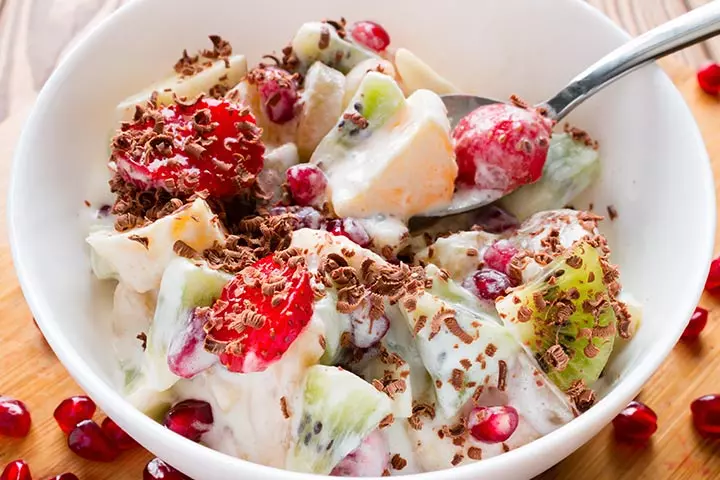
Image: ShutterStock
Congratulations on your baby starting solids. This post on the baby food chart will give you all the required information you have been looking for. The common confusion among mothers who are starting solids for their babies is what to feed their babies. You need to make sure you include all the essential vitamins and minerals in their food and also ensure that it appeals to them. Making sure of all these things can sometimes be a daunting task. We have here to help with just that. Read on as we bring you a list of recommendations for your baby’s food that you can try out. You may also personalize it according to their taste palettes.

When Can Babies Eat Solid Foods?
Let’s see what the experts have to say about this:
According to the American Academy of Pediatrics (AAP), WHO and UNICEF, breastmilk or formula will provide the required nutrition to the baby during the first six months (1).
The AAP also specifies that solid foods should not be given until the baby is four months old, and they are acceptable in between four and six months.
Whether you start at four, five, six or even later, solids will comprise a small portion of your baby’s feeds until a few weeks (2). You are only complementing breast milk or formula feed with solids, but not replacing them altogether. You should first watch your baby sense and taste the food.
How To Know If Your Baby Is Ready For Solid Foods?
There is no standard age for a baby to get ready for the solids. Some seem to be ready around four months, while some a little later. You can look for cues from the little ones to know if it is time for them to eat solid foods: (3)
- The baby loses the tongue thrust reflex. Baby tongue thrust is a natural reflex that prevents the baby from choking with foreign substances. When an unfamiliar substance is put in the baby’s mouth, they spit it out automatically. Usually, this reflex declines at around three to four months, but in some babies, it remains active for a longer time. Until the reflex diminishes, you cannot introduce solid foods to your baby.
- The baby is able to signal that her tummy is full. Your baby can let you know that she is full through signs such as turning away from the breast/ bottle or closing her mouth. This helps you assess how much she can eat, and when to stop feeding her.
- The baby can sit and hold the head in an upright position. This is important because babies who cannot sit up and have to be reclined for feeding have higher chances of choking. The ability to sit with head-control indicates the physical maturity of the baby and their readiness to eat solid foods.
- The birth weight is doubled. It is a rough indication the baby is ready for food other than breastmilk or formula feed. However, you should wait for the baby to show a few more other signs as this alone cannot be the criteria to feed her solids.
There are a couple of other developments which are traditionally thought to be the sign of a baby’s readiness for solid foods but are less reliable.
- The baby is eager to grab your food. Grandmas see this as a sign, but do not rely on this alone because a baby, at around four to six months, is attracted towards any object, which she invariably puts in her mouth.
- The baby wakes up in the middle of the sleep. Though frequent waking up could be a sign, it is just a guess that the little one is hungry. She could wake up for many other reasons such as illness, growth spurt, and teething.
If your baby is not showing any of these signs, then we advise you to wait until she reaches six months of age (4). But what happens if the baby is not ready even after six months?
Is It Ever Too Late To Introduce Solid Foods To Your Baby?
Six months is an ideal time to start solids. If it gets too late, then the babies might face two risks:
- Allergies: The baby is likely to develop food allergies, asthma, hay fever, eczema and others if you introduce solids late in her life.
- Need for iron: Babies have enough iron reserves at their birth. The reserves gradually deplete by the time the babies turn six to eight months of age. The infants are likely to become anemic if the iron levels are not replenished through solid foods.
Myth:
It is a myth that babies who start solid foods late are likely to face difficulty in chewing and swallowing food. Babies will eat when they are ready to eat. If they have crossed eight months but still refuse solids, then you should take them to rule out any developmental issues (5).
However, if the baby gets ready to eat solids within eight months, you may stop worrying and start thinking about her new feed.
The Baby Is Ready To Eat Solids: How To Start And What To Give?
There are two things you should keep in mind when your baby is transitioning to solids: Take the change slowly and keep it simple. Choosing foods is one of the important tasks. A few of the choices are (6):
The baby’s first food chart and why you should choose these foods:
| Fruits | Avocados, pears, banana, apples | Slightly sweet, smooth and creamy; loaded with essential nutrients; easy to digest. |
| Vegetables | Butternut squash, sweet potatoes, green beans | Orange vegetables are tasty, smooth and creamy; loaded with vitamins A and C and iron; green beans are packed with essential nutrients. |
| Grains | Rice, oats | Traditional starter grains; not allergenic; easy to digest. Brown rice and steel cut oats also offer high nutrients. |
Stage 1 baby foods
- First foods to offer
- Have a single ingredient and pureed
- Easy to monitor any food allergies
Stage 2 baby foods
- Similar to stage 1 foods
- More than a single ingredient (combinations of fruits or vegetables)
- Strained instead of pureed
Stage 3 baby foods
- Mashed and more textured than pureed foods
- Contains bits and chunks of veggies or meat
- Baby weans quickly to table food
What Is The Four-Day Wait Rule?
Remember:
You may choose to begin solids with any staple food, but you need to introduce one food at a time. Whenever you offer a new food, wait for four days before you try another variety, to make sure that your baby is not allergic to the first food.
If you have a family history of allergy for a particular food, avoid giving it until the baby crosses one year.
Some pediatricians suggest that parents wait beyond one year if there is a history of allergies for foods such as fish, eggs, wheat and peanuts. Therefore, consult your child’s doctor before introducing any such foods.
By the time your baby reaches around nine months, you may have fed her a variety of foods and got an idea on her favorite foods or those which are allergenic. The four-day wait rule is not necessary at this stage but you may still want to be careful when introducing new foods.
How To Feed Your Baby?
Begin with less than half a teaspoon, and try talking to your baby through the feeding process. She may reject the food initially but you should figure out the best way to feed her.
One way is to begin with some breastmilk or formula, then feed half a teaspoon of solid food and finish with breastmilk or formula. It will help your baby take in the food quickly. Increase the food size gradually.
Do not feed if your baby is crying or turning away from the feed. Breastfeed or bottle-feed for a while before you try again. Introducing solid foods takes time. Each baby is different, and so is the readiness to start solids.
What Baby Foods Are In Sync With The Developmental Stages?
Growth varies between children. Some are quick while some others take time to reach their developmental milestones. Similarly, their liking for solid foods also may differ. Some babies begin to like mashed purees in the fourth month itself, while some others wait until they reach the eighth month.
Here we give you the foods you may feed your child at each stage of her development (7) (8)
Birth to four months: exclusive breastfeeding or formula feeding
As mentioned earlier, breast milk is the only safe and nutritious option for a baby until they show readiness to eat solids.
- The baby’s digestive system is still developing, and milk is the easiest food for her to digest.
- If the breast milk supply is low, you can complement it with formula food. But do not replace it completely.
- The best way to improve the milk supply is to continue giving breast milk to your baby and to have a proper diet.
Four to six months: starts eating
Although it is not recommended to introduce solid foods before six months of age, you may feed her tiny portions after four months, if she is ready to eat.
What to feed?
- Breastmilk or formula feed
- Fruits: avocados, apples, bananas, pears and peaches
- Vegetables – butternut squash, green bean, sweet potatoes
- Cereals and grains – rice, barley, oats
- Protein – none
- Dairy – none
How to feed?
- Prepare one tablespoon sized portions of pureed vegetable, fruit or cereal. Make it thin and runny.
- As your baby turns older and is eating more portions, you can gradually increase the portion size to two tablespoons.
- Some parents use their fingers to feed the baby. It helps them take the solids easily.
- Milk continues to be more important than solids at this stage.
Feeding tips:
- If your baby refuses to eat the first food you offer, wait for a few days and try again.
- Provide each new food with a gap of about three to four days (follow the three-day wait or four-day wait rule)
- Note down the foods you are offering your baby. If she develops any allergic reaction, it would be easier to find the causative food.
Note:
If your baby is prematurely born, cross check with your child’s pediatrician about the best age to give solids. The correct age can be determined by subtracting the number of weeks or months the baby was born prematurely from her current age. For instance, if she is six months now, and was born eight weeks before her actual due time, her age will be four months.
Six to eight months: moving forward
At around this age, breastmilk or formula feed are still required for nutrition. However, you can slowly increase the quantity of solid food.
What to feed?
- Breastmilk or formula feed
- Fruits – apples, avocados, apricots, bananas, peaches, pears, mangoes, nectarines, plums, prunes and pumpkin
- Vegetables – carrots, squash, sweet potato, green beans, peas, zucchini, parsnips
- Cereals and grains – rice, barley, oats
- Protein – chicken, beef, tofu, turkey
- Dairy – unsweetened yogurt (not made of cow’s milk)
How to feed?
- Begin with one-fourth to half-a-cup of pureed fruit or vegetable or cereals a day.
- Increase the portion sizes when your baby gets used to eating solids.
Feeding tips:
- Give one food at a time. Give a gap of three to four days between introducing new foods.
- The baby may show preference to a particular food. Know what foods she can eat, and make healthy varieties.
- Meats should be cooked and then pureed or chopped into small pieces.
Eight to ten months: exploring new foods
Now that she is learning to hold things, she tries picking up objects with thumb and forefinger (pincer grasp). She puts everything in her mouth and learns to chew.
What to feed?
- Breastmilk or formula feed
- Fruits – avocados, bananas, pears, peaches, apricots, apples, blueberries, cherries, cantaloupe, dates, grapes, papaya, figs, kiwi, nectarines, plums, pumpkin, prunes
- Vegetables – squash, potatoes, sweet potatoes, carrots, broccoli, cauliflower, eggplant, mushrooms, peas, peppers, zucchini
- Cereals and grains – amaranth, barley, millets, oats, buckwheat, flax, wheat, rice, sesame, wheatgerm, spelt
- Protein – legumes/beans, chicken, turkey, beef, pork, fish, tofu, eggs
- Dairy – soft pasteurized cheeses and unsweetened yogurt
How to feed?
- Your baby can eat three meals a day. It may include one-fourth cup of dairy, cereal, protein-rich food, fruit/ vegetable. You can give them separately or in a combination.
- Your baby will also enjoy snacking finger foods once or twice in between the meals.
Feeding tips:
- You can add some spices to the mashed or chopped fruits, vegetables, dairy, pasta, and meats.
- Meats and protein foods should be cooked and pureed or chopped into small pieces.
- Tofu requires no cooking. It can just be pureed and fed.
- Offer her a balanced diet of fruits, vegetables, grains, and proteins.
- Try setting a feeding schedule based on the baby’s hunger cues.
Ten to 12 months: eating with ease
The baby can swallow food easily, develops more teeth and stops to push food out with her tongue. She also develops fine motor control skills and would want to use a spoon.
What to feed?
- Breastmilk or formula feed
- Fruits – citrus, berries
- Vegetables – cucumbers corn, tomatoes, spinach
- Cereal and grains – any type
- Protein – any fish, whole eggs, meat, poultry, beans
- Dairy – whole milk, soft pasteurized cheeses, yogurt
How to feed?
- By now, your baby will have a better appetite, and her intake increases.
- You should be introducing whole milk. Ease the change by alternating between breastmilk and whole milk.
Feeding tips:
- Continue to expand your little one’s palate by adding new flavors.
- Add new spices and try flavorful combinations.
- Cook pasta, fruit and vegetables softly and mash them.
- Proteins and meats can be cooked and pureed or chopped.
Even though your baby begins to eat solids, you cannot go ahead and feed her just about any food.
Foods To Avoid In The First 12 Months
Restrain from giving foods that could choke the baby, cause allergies, have high levels of sugar and salt (8).
- Raw green peas, string beans, celery
- Raw or cooked whole corn kernels
- Hard pieces of raw fruits
- Whole berries, grapes, melons, or cherry tomatoes
- Dried fruits and nuts
- Sausages, hot dogs and meat sticks
- Large chunks of meat
- Large pieces of cheese
- Peanut butter and other nut butters
- Hard candies and jelly beans
- Popcorn, pretzels, potato chips
- Marshmallows
- Cookies, puddings, candies and cakes
- Soda, fruit punches and other drinks
What Are Some Key Points To Remember When Feeding Solids To Your Baby?
- Wash your hands and sterilize the utensils and bowls to prepare food and feed your baby.
- Focus on your baby while feeding her to avoid any risk of choking.
- Serve fresh food all the time to prevent any loss of nutrients. Feed the prepared food within one hour.
- Do not add salt, sugar, ketchup, or any extra fats to your baby’s food at least in the initial months.
- Use a small dish for feeding. Do not feed directly from the jar or a large dish.
- Use a blender, strainer or baby food grinder for preparing food.
- Discard the leftover food to avoid contamination.
- Boil and cool the water before using it to prepare baby food.
- The baby may not be able to eat properly in the beginning, but you should help her get used to the experience of eating.
- Introduce a variety of foods so that the baby gets used to different tastes and textures. It also helps in smooth transition from pureed foods to mashed, finger foods and family meals.
- Be patient while trying out different varieties. Your baby may not like all the foods and tastes.
What Changes Can You Expect When Your Baby Starts Solids?
The changes are visible in the stool of your baby. It becomes solid, varies in color and has a strong odor (9).
- The added sugars and fats are responsible for the odor.
- The stool turns green due to green vegetables, red if your baby eats beets and likewise with other foods.
- If the food is not strained properly, the stool may contain undigested pieces of food
All these are normal as your baby’s digestive system is still immature and takes time to process the foods.
If the stools are extremely watery or filled with mucus, it is due to the irritated digestive system. In this case you should reduce the solid portions. If the stools continue to be watery and mucus, take your baby to a doctor.
Why Is Homemade Food Best For Your Baby?
Although ready made and packaged foods are easy to get, homemade foods are more beneficial for your baby.
- They are fresh, delicious and economical (10).
- You know about the ingredients that go into your baby’s diet.
- You can plan the right meal with necessary nutrition.
- You can protect her from preservatives and artificial ingredients.
- You can make your set of combinations based on the child’s liking and need.
Moreover, it can be made with lots of love!
Homemade Food Recipes For Your Baby
1. Rice cereal (for four months and above)
You will need:
- 1/4 cup rice powder (blend rice in a blender or food processor)
- 1 cup water
How to:
- Add rice powder to the boiling water and stir it continuously.
- Simmer it and keep stirring.
- You can serve as such, or along with breast milk or formula.
Note:
Oat cereal and barley cereal may also be prepared the same way. Use ground oats or barley instead of rice.
2. Banana puree (for 4+)
You will need:
- One banana (ripe)
How to:
- Peel ripe banana and blend it in a food processor.
- You can also mash it in a bowl using a fork. Heat in a microwave for about 25 seconds for extra softness, and then mash.
- For a thinner consistency, add breast milk or formula.
Note:
You can also make other fruit purees in the same way.
3. Green beans (for 4+)
You will need:
- Fresh green beans
- Water
How to:
- Open the pods and scrape away the seeds.
- Add enough water and put them into steam until they turn tender.
- Blend them and serve the puree.
4. Carrot puree (for 4+)
You will need:
- Carrots
- Water
How to:
- Peel and cut small chunks of carrot.
- Add water and put them into steam.
- Strain away the water and puree.
- You can add the required amount of water for a thinner consistency.
5. Oatmeal with apples (for 8+)
You will need:
- ¼ cup of rolled oats
- ½ apple
- 1 cup water
- A pinch of cinnamon powder
How to:
- Combine oats, water, and cinnamon powder. Grate the apple into it.
- Now put them over a medium heat flame and boil the mixture.
- Stir constantly until the meal thickens.
- Cool before serving.
6. Root veggie mash (for 8+)
You will need:
- One carrot
- One parsnip
- One sweet potato
How to:
- Preheat the oven to 190 degrees C. Cut the veggies into small pieces and toss them in the baking dish.
- Add about one-fourth cup of water, and cover the bowl.
- Bake the vegetables for 30 to 40 minutes.
- Transfer into a bowl and mash it into a chunky puree using a fork. Mix well and serve.
7. Lentil and spinach stew (for 8+)
You will need:
- 2tsp olive oil
- 1 carrot (finely chopped)
- ½ cup dried lentils
- 2 cups chicken or vegetable broth
- 1 cup baby spinach
How to:
- Warm olive oil in a medium flame.
- Add carrot and cook for three minutes.
- Add lentils, broth, and put it to high heat. Let it boil and then lower the heat. Keep stirring for about half an hour.
- Add spinach and cook until the leaves turn wilted.
- Add a little more broth if the stew is thick.
- Let it cool before serving.
8. Rice with peas, carrot and egg (for 10+)
You will need:
- 1tsp olive oil
- 2tbsp carrot (shredded)
- 2tbsp fresh peas
- ½ cup brown rice (cooked)
- 1 egg
How to:
- Warm olive oil in a small frying pan
- Add carrot, and cook for three minutes.
- Add peas, water and cook for another three minutes.
- Mix with rice and cook for some time.
- Add beaten egg and cook until the egg is fully cooked.
- Serve after cooling it.
9. Tropical fruit salad (for 10+)
You will need:
- 2-3tbsp plain whole milk or Greek yogurt
- 1tbsp unsweetened coconut (shredded)
- ¼ cup kiwi (finely chopped)
- ¼ cup mango (finely chopped)
- ¼ cup banana (finely chopped)
How to:
- Combine yogurt and coconut in a bowl.
- Add all the three fruits and stir gently
- You can serve it fresh
10. Pasta with spinach and ricotta cheese (for 10+)
You will need:
- ½ cup whole wheat pasta
- 1tsp olive oil
- 1 cup baby spinach
- 1/3 cup ricotta
- 1tsp lemon zest (finely grated)
How to:
- Boil water with salt added into it. Add pasta to the boiling water.
- Drain the water, and reserve some of it.
- Warm olive oil in a separate frying pan.
- Add spinach and cook for two minutes.
- Now transfer spinach into another bowl. Add ricotta, lemon zest and pasta and mix well.
- You can add some warm water if it is too thick.
Introduction of solid foods is a crucial stage in your baby’s first year. They develop a taste for these foods, begin to grow faster, and avoid any malnutrition issues. However, you need to begin with baby steps, so start with a spoonful of food, and then increase it gradually. If your baby is not liking it or spitting the food out, give them time to adjust to the new routine. Remember, do not force-feed the little one.
Frequently Asked Questions
1. Can I give juice to my baby?
Give juice only when your baby is ready to drink from a cup. The baby should be more than six months of age (11). The juice should be 100% and free of added sugars and preservatives. You can give not more than two ounces a day because juices reduce the appetite of the baby, and too much juice can cause diarrhea, excessive weight gain, diaper rash and tooth decay (12).
2. Does my baby need water?
Breastmilk or formula feed will provide the required hydration to the baby. Babies do not need water until six months as giving water at this age can reduce their ability to absorb the required nutrients from the breastmilk or formula. However, when you start giving solid foods, water can be added to the diet. You may give water to the baby in very hot weather (13).
At six to eight months, give about four to eight ounces of water every day. At around ten months, they can take as much water as they want (14).
Most babies can begin eating solids at six months. Initially, you should give them small quantities of single-ingredient, easily digestible foods in well-cooked puree or mash forms. Observe the “four-day wait rule” before introducing the next food to rule out any intolerance or allergy. As the baby adjusts to the food’s taste and digestibility, you can feed them multi-ingredient foods and increase the total quantity fed. Follow additional precautions to ensure the baby doesn’t choke on foods or eat foods high in sugar and salt. Remember, the baby should eat solids with continued breastfeeding or formula feeding until they turn one.
References
- Arthur I. Eidelman et al.; (2012); Breastfeeding and the Use of Human Milk.
https://publications.aap.org/pediatrics/article/129/3/e827/31785/Breastfeeding-and-the-Use-of-Human-Milk - Alice A. Kuo et al.; (2011); Introduction of Solid Food to Young Infants.
https://www.ncbi.nlm.nih.gov/pmc/articles/PMC3195680/ - Starting Solid Foods.
https://www.healthychildren.org/English/ages-stages/baby/feeding-nutrition/Pages/Starting-Solid-Foods.aspx - Introducing Solid Foods to Infants.
https://extension.colostate.edu/topic-areas/nutrition-food-safety-health/introducing-solid-foods-to-infants-9-358/ - When What and How to Introduce Solid Foods.
https://www.cdc.gov/nutrition/infantandtoddlernutrition/foods-and-drinks/when-to-introduce-solid-foods.html - Working Together: Breastfeeding and Solid Foods.
https://www.healthychildren.org/English/ages-stages/baby/breastfeeding/Pages/Working-Together-Breastfeeding-and-Solid-Foods.aspx - Infant and Toddler Feeding from Birth to 23 Months: Making Every Bite Count.
https://foodinsight.org/starting-solids-a-resource-for-parents-and-their-infants/ - Food to Grow on.
https://health.mo.gov/living/families/wic/pdf/R_0618_Foods_To_Grow_On.pdf - What are some of the basics of infant health?
https://www.nichd.nih.gov/health/topics/infantcare/conditioninfo/basics - People at Risk: Children Under Five.
https://www.foodsafety.gov/people-at-risk/children-under-five - Drinks to give your baby 0 to 12 months.
https://www2.hse.ie/babies-children/weaning-eating/nutrition-baby/drinks/ - Feeding Your Baby.
https://www.michigan.gov/documents/mdch/WIC_6-12Months-Brochure_WEB_455888_7.pdf - Feeding Guide for the First Year.
https://www.urmc.rochester.edu/encyclopedia/content?contenttypeid=90&contentid=P02209 - Keeping Your Baby Hydrated During Summer.
https://riseandshine.childrensnational.org/keeping-your-baby-hydrated-during-summer/
Community Experiences
Join the conversation and become a part of our nurturing community! Share your stories, experiences, and insights to connect with fellow parents.
Read full bio of Dr. Shikha Sharma
Read full bio of Swati Patwal


